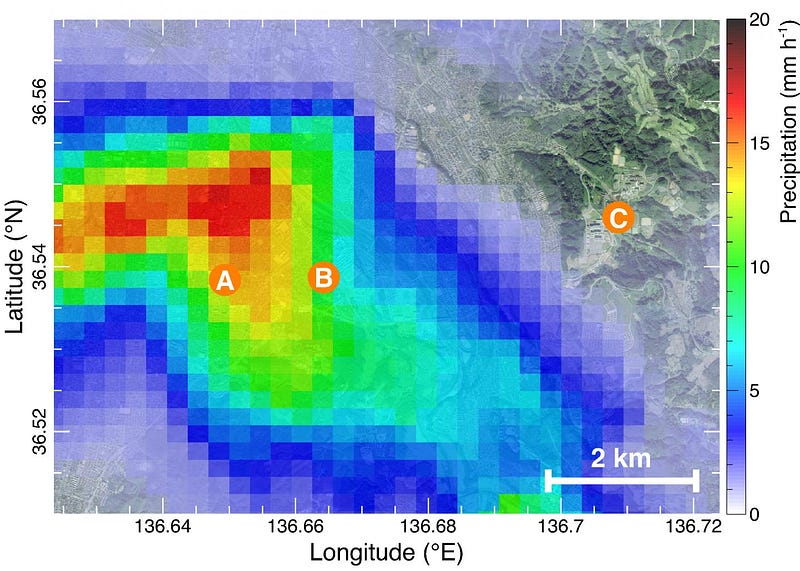Unveiling the Connection Between Thunderstorms and Gamma Rays
Written on
Chapter 1: Understanding Thunderclouds and Gamma Radiation
Thunderclouds can hold an astonishing charge of over 1 billion volts of electricity (Wada, 2019). Recent studies have revealed intriguing gamma-ray activities linked to lightning strikes. Researchers, including Yuuki Wada from the University of Tokyo, have found that under specific conditions, faint gamma-ray emissions from thunderclouds can occur prior to lightning strikes and their subsequent gamma-ray bursts.
For nearly thirty years, the scientific community has recognized that thunderstorms can produce gamma-ray phenomena. As Wada notes: “Historically, people have witnessed lightning and heard thunder, which were our only ways to perceive nature’s might. The advent of electromagnetism allowed scientists to detect lightning using radio equipment. Now, we can observe it through gamma rays — a form of ionizing radiation. It’s akin to having multiple perspectives to analyze these phenomena.”

- Gamma-ray glow preceding a gamma-ray flash. (Yuuki Wada and Hayanon's Science Manga Studio, 2019)
Researchers have identified two primary types of gamma-ray phenomena in relation to thunderclouds: the weak emissions known as gamma-ray glows, which last around one minute, and the more intense, short-lived terrestrial gamma-ray flashes (TGFs) that correspond to lightning strikes. These phenomena occur in areas of thunderclouds where there are layers of differing electrical charge. Within these charged regions, electrons accelerate to nearly the speed of light. When these electrons approach nitrogen nuclei in the atmosphere, they decelerate slightly and emit gamma rays, a process known as bremsstrahlung radiation.
The gamma-ray emissions from these flashes are relatively low, estimated at about one-tenth of what one would encounter during a typical medical X-ray. To investigate this, Wada and his team collaborated with local schools and businesses to set up radiation monitors across various buildings in Kanazawa, Ishikawa Prefecture, Japan. This network of monitors is capable of detecting radiation from the atmosphere.
Wada elaborates: “During a winter thunderstorm in Kanazawa, our monitors captured a simultaneous TGF and a lightning strike. While this occurrence is not unusual, we also observed a gamma-ray glow in the same vicinity. Remarkably, the glow ceased abruptly when the lightning struck. We can assert with confidence that these events are closely linked, marking the first documented observation of this connection.”

- A thundercloud above Kanazawa, where the gamma-ray glow ceased near location B, while lightning struck between locations A and B. (Wada, 2019)
Understanding the mechanisms behind lightning discharge is a critical area of research, and this study could provide new insights. Wada and his team plan to expand their research to investigate whether gamma-ray glows not only precede lightning but might actually trigger it. He states: “Our findings represent a significant advancement in lightning research, and we aim to increase our radiation sensor count from 23 to around 40 or 50. With more sensors, we can significantly enhance predictive models.”
With enough data, the researchers hope to predict lightning strikes within approximately 10 minutes and within a radius of about 2 kilometers. Wada expresses enthusiasm for continuing this research, particularly since Kanazawa offers unique meteorological conditions conducive to such investigations. Unlike typical scenarios where radiation monitoring occurs from airborne or mountain-based stations, the winter storms in Kanazawa bring thunderclouds closer to the ground, making it a perfect setting for studying these phenomena with low-cost portable monitors developed by Wada's team.
These portable radiation detectors were partly built using technology initially designed for space-based satellite observatories for astrophysical research, making them quite exceptional. The findings from this research could have profound implications not only for astrophysics but also for understanding solar physics, particularly in the context of particle acceleration.
Moreover, this research could have practical applications in fields closer to home. For instance, paleontologists utilize carbon-14 dating to ascertain the age of samples from the past 50,000 years, a method that depends on the atmospheric ratios of carbon isotopes, carbon-12 and carbon-14. Wada explains: “It is generally accepted that carbon-14 forms at a relatively constant rate due to cosmic rays, which underpins the reliability of this dating technique. However, there is evidence suggesting that thunderstorms may influence the carbon-12 to carbon-14 ratio, potentially affecting the accuracy of carbon-14 dating.”
Wada and his team will continue to unravel the mysteries surrounding lightning, one of nature's most fascinating phenomena. In collaboration with a French project, they plan to launch a dedicated satellite to observe lightning patterns from space.
Chapter 2: Gamma-ray Emissions and Thunderstorms
In this insightful video, Joseph Dwyer discusses "Gamma-ray Emissions from Thunderstorms," presenting groundbreaking findings from the 2018 UMBC Colloquium.
This video elaborates on "Gamma-ray Emissions from Thunderstorms: Dark Lightning and Related Phenomena," providing an in-depth look at the various aspects of gamma-ray activity associated with thunderstorms.